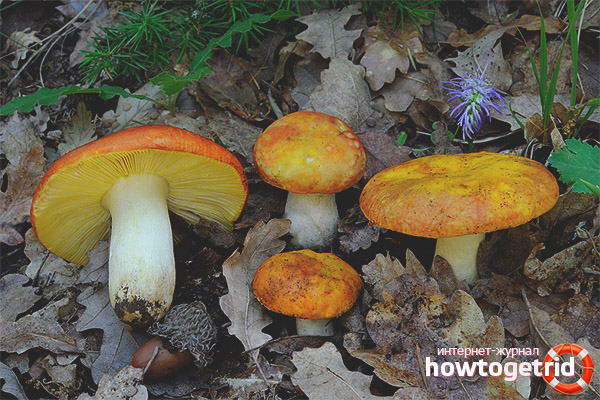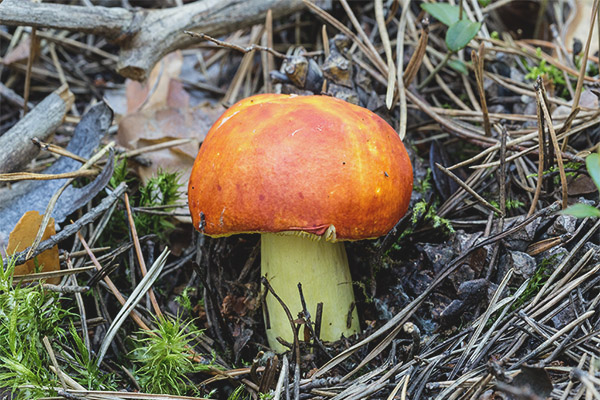The content of the article
It is worth noting the interesting fact that the fruit bodies in question are among the most popular mushrooms. Russula distributed throughout the world. In addition, such instances are very easy to collect. Due to the bright and memorable color, such fruits without problems can be found in a wooded area. Almost all representatives of this species have a pleasant taste and aroma. Therefore, in the culinary world, they are very much appreciated.
Description
- Fruit bodies can have a cap in diameter of not more than 12 cm. If we take into account young specimens, then they have a convex shape. Only over time, the hat becomes prostrate. Often you can see a recess in the center. Edges gain ribbed structure.
- The surface of young fruit bodies glossy and smooth. You may also notice that it is covered with mucus. The color of the cap is almost always red-brick.More adult fruits have an opaque and velvety surface. Their color is often ocher-yellow or orange with reddish spots.
- As for the general structure of the fruit body, the flesh is crumbling and brittle. In most cases, has a whitish tint. At the same time, after cutting the mushrooms, the color does not change. Under the cap are frequent plates that fit snugly to the leg. They are rounded to the edges of the cap.
- In young fruit bodies, the plates are cream colored. Only with age do they acquire a yellow tint. As for the leg of the fungus, it has a cylindrical shape. It can be up to 8 cm in height, and up to 3 cm in thickness. It is often possible to see that the surface of the stem can be smooth or wrinkled. It is white, but with a yellowish tinge.
Spread
- Considered fruit bodies often grow in forests with old oaks, beech, hazelnut, spruce and aspen. Also in such forests there can be linden, elm and similar broad-leaved trees.
- In most cases, such specimens prefer to choose a carbonate soil. The fruiting season falls in the middle of summer. It ends in the middle of autumn.Instances can be found singly or in small groups.
Virulence

Mushrooms are edible. However, such specimens can not boast of high taste and bright rich mushroom aroma as compared with their relatives. This applies to raw fruits. When cooking mushrooms gain a completely different, pretty good taste and aroma.
Similar species
- The russula is similar to the discussed fruit bodies. This copy refers to edible mushrooms. A hat of such russula in diameter can reach up to 12 cm. Separately, it is worth noting the fact that in young fruit bodies the hat looks in the shape of a ball.
- Over time, it takes the form of a bell. Old fruit bodies can already be seen with a flat cap. It also has an old skin, and it is separated from the pulp without any problems. Often the cap is colored yellow-brown. The leg has a dense structure and white color. It is rare to see spots on it.
- In most cases, the legs of these mushrooms are almost flat, only sometimes they thicken closer to the ground.These russula can often be found in Russian forests. About 48% of all other fruits fall on this type of fruit bodies.
- In most cases, mushrooms salted. The problem is that they have a rather bitter taste. Therefore, before salting them, it is imperative to soak and get rid of the skin from the cap.
- There is also another species that looks like our mushrooms. Breaking russula is considered conditionally edible fruit body. It has a small size. The diameter of its cap can be a maximum of 6 cm. Most often it is painted in a pinkish-purple hue. In young specimens, the cap is initially convex.
- Over time, it begins to open and eventually becomes arched. At the edges of the cap, small scars can be seen. The leg has the shape of a cylinder, while it is completely flat and powdery. The color is white. Brittle russules are very common. They grow in deciduous, coniferous and mixed forests.
- Such specimens prefer acidified soil. Therefore, you can easily find these mushrooms under birch, pine, hornbeam, oak and other trees. The fruiting season falls at the end of summer and mid-autumn.Mushrooms can be found in the European part of Russia. They also grow in the Baltic States, Karelia, Ukraine and Belarus.
Golden russula is quite common throughout the world. As for the collection of such fruit bodies, then you should have no problems with it. The distribution of these instances is quite extensive. After cooking, the mushrooms acquire excellent taste and pleasant aroma.











To send